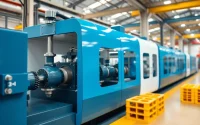Understanding Machine Vision: Applications, Benefits, and Future Trends
Introduction to Machine Vision
As industries continue to evolve digitally, machine vision has emerged as a pivotal technology, transforming the landscape of automation processes across numerous sectors. By enabling machines to interpret visual information in a way comparable to human sight, machine vision plays a crucial role in enhancing productivity, accuracy, and quality in manufacturing and beyond.
What is Machine Vision?
Machine vision refers to the technological capabilities that allow machines to interpret and act on visual information extracted from their environment. This technology employs various components, such as cameras, sensors, lighting, and software algorithms, to capture and analyze images, enabling automatic inspections, measurements, and assessments across diverse applications.
In essence, machine vision involves several crucial steps:
- Image Acquisition: Using cameras and lighting setups to capture images of objects in the environment.
- Image Processing: Employing software algorithms to analyze and interpret these images, detecting features such as edges, shapes, and patterns.
- Decision Making: Making informed decisions based on the analysis, which may include enabling or disabling machinery, suggesting repairs, or categorizing products.
Key Components of Machine Vision Systems
For a machine vision system to function effectively, it requires several key components:
- Cameras: Different types of cameras, such as CCD and CMOS, are employed to capture images. The choice often depends on the specific application and required resolution.
- Lighting: Proper illumination is essential for highlighting product features and obtaining clear images. Techniques like backlighting or spotlighting may be used depending on the inspection requirements.
- Processing Hardware: This includes computer systems capable of running machine vision software that interprets the image data. High-performance GPUs may be incorporated to speed up processing times.
- Software Algorithms: Machine vision software utilizes algorithms for tasks like pattern recognition, edge detection, and other forms of image analysis. Advanced machine learning models are increasingly being integrated for enhanced capabilities.
- Communications Interfaces: These allow machine vision systems to interact with other systems, facilitating data exchange and decision-making processes.
Differences Between Machine Vision and Computer Vision
While machine vision and computer vision share common technological foundations, they serve different purposes within various applications:
- Machine Vision: Primarily focused on automation in industrial processes, machine vision is used for specific tasks such as quality control, assembly verification, and defect detection.
- Computer Vision: Broader in scope, computer vision encompasses the discipline of enabling machines to interpret and understand visual information from the world at large. Applications can include facial recognition, autonomous vehicles, and augmented reality.
Applications of Machine Vision
Machine vision technology has found a diverse array of applications across multiple sectors. Here, we explore a few notable use cases.
Industrial Applications
In industrial settings, machine vision is utilized extensively for automation and quality assurance. Typical applications include:
- Quality Inspection: Automated systems equipped with machine vision can inspect products on assembly lines, checking for defects, verifying measurements, and ensuring consistent quality without human intervention.
- Sorting and Classification: Machine vision can effectively sort products by detecting physical attributes such as size, shape, and color, ensuring only acceptable items proceed to the next production phase.
- Barcode and QR Code Scanning: Automated scanning systems streamline inventory management and logistics by quickly processing codes on products for tracking and identification.
Machine Vision in Quality Control
Quality control is a fundamental aspect of manufacturing, and machine vision plays an essential role:
- Real-Time Monitoring: Machine vision systems offer continuous monitoring capabilities, enabling quick detection of quality deviations.
- Data Recording: Every inspection can be digitally recorded, providing invaluable data for process optimization and compliance with industry standards.
Robotics and Automation Integration
Machine vision is increasingly being integrated into robotic systems, enhancing their capabilities:
- Guided Robotics: Robots equipped with machine vision can navigate environments and perform tasks such as assembly or handling products with precision based on visual feedback.
- Autonomous Machines: In sectors like agriculture and warehousing, machines can operate autonomously with computer vision systems that help in object detection and path navigation.
Benefits of Implementing Machine Vision
Implementing machine vision systems yields numerous advantages that benefit organizations greatly:
Improved Accuracy and Efficiency
Machine vision systems provide unparalleled accuracy in inspections, minimizing human error. They can operate continuously without fatigue, contributing to higher efficiency and output rates.
Cost Reduction and Waste Minimization
By automating quality checks and inspection processes, organizations can save labor costs and minimize resource waste due to defects. Early detection of quality issues prevents costly recalls and reworks.
Real-Time Monitoring and Data Collection
Machine vision technology facilitates real-time data collection for analysis, allowing companies to monitor production processes continuously. This wealth of data fosters improvements in production planning, predictive maintenance, and overall operational efficiency.
Challenges in Machine Vision Implementation
Despite its many advantages, several challenges exist in the implementation of machine vision systems:
Common Technical Hurdles
Technical challenges include system calibration, compatibility with existing infrastructure, and ensuring adequate processing power. Organizations must invest time in training personnel and ensuring that systems are tailored to specific applications.
Environmental Factors Impacting Performance
Environmental conditions such as lighting, dust, and vibrations can adversely affect machine vision performance. Implementing proper lighting solutions and protective casings can alleviate these issues.
Data Security and Privacy Concerns
As machine vision systems collect extensive data, data security becomes a significant concern. Organizations must establish robust cybersecurity measures to protect sensitive information and comply with regulations.
The Future of Machine Vision Technology
The future of machine vision looks promising as advancements continue to propel the technology forward. Emerging trends include:
Emerging Trends and Innovations
Among the most significant trends are advancements in deep learning and artificial intelligence, which are enhancing machine vision systems by improving their capacity for complex image recognition and decision-making processes.
Machine Vision in Artificial Intelligence
AI integration allows machine vision systems to learn from past data, adapting their processes over time. This leads to increasingly sophisticated inspections and decisions that improve quality and operational efficiency.
Potential Market Developments
The machine vision market is set to grow exponentially, with adoption in various sectors such as healthcare, automotive, and consumer electronics. As the technology becomes more accessible and affordable, its presence in smaller manufacturers will also rise.


